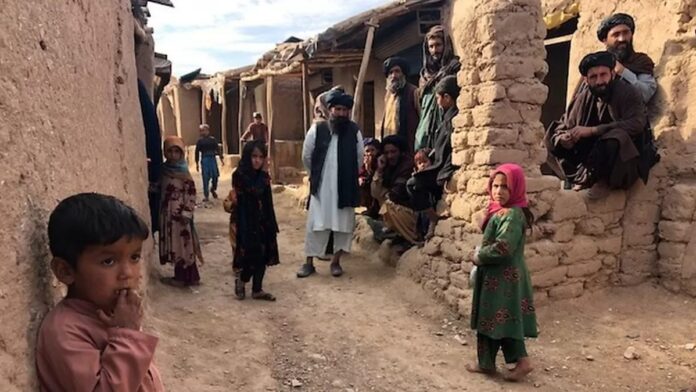In 2022, a deepening economic crisis persisted in Afghanistan, catalyzed by several factors, including massive donor aid cuts in 2021 and corresponding wage cuts for essential workers; a severe liquidity crisis; skyrocketing prices for necessities like food; economic restrictions by the international community. Besides, the de facto government’s suppression of young girls and women – who bear the maximum brunt of the crisis – has also deteriorated the already boiling quandary.
With a potential institutional collapse and human disaster, Afghanistan is currently experiencing an unprecedented humanitarian crisis. Along with the unfathomable human sacrifices, this humanitarian crisis is rolling back many accomplishments made over the previous 20 years, especially those related to women’s rights. After the previous administration fell, the direct overseas development assistance that had previously accounted for 75% of all public spending, including the upkeep of the public health system, was suspended. The rise in humanitarian needs across Afghanistan is proof that, in the absence of development activity, the Afghan people are facing a retrograde slide.
The main causes of humanitarian need in 2023 will be multifaceted, as opposed to recent years when conflict has mainly been the primary driver. These factors include drought, climate change, challenges to women’s and girls’ safety, the economic crisis, and protection dangers generally. Nevertheless, armed conflict, natural catastrophes, the residual repercussions of war, and current large-scale conflict displacement continue to inhibit people from developing resilience and progressing toward rehabilitation and solutions.
With 49% women and girls and one of the largest youth populations in the world (47% of the population under 15), Afghanistan’s population was estimated at 43 million people in 2022. The interrelated environmental, economic, and protection concerns, particularly for girls, will have a far-reaching and perhaps catastrophic effect far into the future because of the population growth rate, which is anticipated to be 2.3% annually, one of the steepest rates in the region. Most women-led households did not have enough food for most of 2022, says the World Food Program, and nearly all of them are now resorting to “draconian measures” to get food, like selling essential household items, putting kids to work, or marrying off young girls for dowry.
In the past six months, more than half of households in Afghanistan have experienced an economic shock, illustrating the severity of the country’s economic crisis. The abrupt suspension of direct development assistance, the freezing of US$9.5 billion in central bank reserves, the disruption of markets, financial, and trade institutions, and the freezing of loans all contributed to the economy’s precipitous freefall.
As Afghanistan enters its third consecutive year of drought-like conditions and its second year of crippling economic decline, while still suffering the effects of 40 years of conflict and frequent natural disasters, an astounding 28.3 million people (two-thirds of the country’s population) will require urgent humanitarian assistance to survive. The average household’s debt has increased due to high unemployment rates and ongoing increases in the pricing of major commodities, making it harder for families to manage their finances and putting a strain on the already fragile economy.
Within this reality, 17 million people face acute hunger in 2023, including 6 million people at emergency levels of food insecurity, one step away from famine – and one of the highest figures worldwide. Deterioration is expected in the first quarter of 2023 due to the simultaneous effects of winter and the lean season, sustained high food prices, reduced income and unemployment, and continued economic decline.
The crisis has a disproportionately negative impact on women and girls, who also have more difficulty getting access to food, medical care, and financial resources. The issue worsened under Taliban rules that prohibited women from working in the majority of paid positions, especially in households where women were the sole or primary wage earners. According to numerous surveys, Afghanistan is the worst country in the world to be a woman or a girl, and matters have only gotten worse since the Taliban seized power and began severely restricting the rights of women and girls. Restrictions aimed against women and girls have a severe impact on many aspects of their lives, restricting their freedom of movement and preventing them from accessing vital services and livelihoods.
Since August 2021, Afghan women staff’s involvement in the humanitarian response has declined in the context of broader humanitarian access. When the Taliban did permit women to work, it was often under repressive conditions that made it nearly impossible for them to do so, such as having a male family member accompany them to work and even stay with them during the entire workday. Women who work in humanitarian aid encounter a growing number of obstacles that limit their access to basic freedoms, rights, and their capacity to travel to beneficiaries. Millions of individuals around the nation will be negatively impacted by the 24 December 2022 decree banning women from working for national or foreign NGOs, which will also prohibit millions of weak women and girls from getting services and life-saving aid.
Even with the country’s humanitarian requirements already being met by two-thirds of the population in 2023, further deterioration is very likely unless the core causes and motivators of need are addressed. To lessen reliance on humanitarian actors for emergency care and shift to longer-term support, significant investments in water infrastructure, sustainable agriculture, alternative livelihoods, gender policy reform, and macroeconomic stabilization are urgently required. These investments must also be made in conjunction with the stabilization of services supporting basic human needs, particularly health care and social services.
Lifting the ban on women’s work and girls’ education should be at the heart of addressing the country’s humanitarian, economic, and social rebuilding needs. With the Taliban’s current and ever-increasing hard-line approach towards girls and women, the country will be deprived of almost half of the population that could comprise and support the economic workforce. Afghan de facto authorities must choose if they wish to avert a further crisis or fuel it for the worst.
(Statistics are taken from OCHA)




